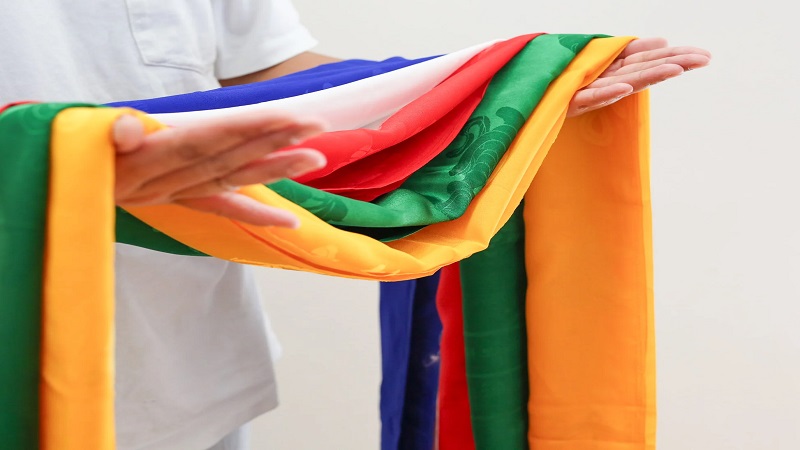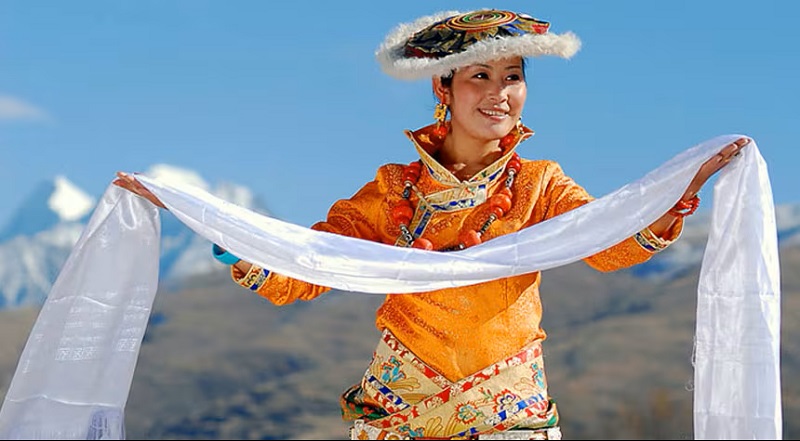Khata – also spelled Hada in Mongolian contexts – is an unassuming length of fabric that carries enormous cultural weight across Tibet, Mongolia, and Himalayan Buddhist regions. To international travelers, a Khata might first look like a decorative silk scarf. But to the people who give and receive it, a Khata is a compact bundle of blessing, respect, and social ritual.
What Is Khata?
A Khata is a ceremonial scarf, usually made of silk or fine woven fabric, presented as a gift or offering in Tibetan and Mongolian cultures and in communities influenced by Tibetan Buddhism. The scarf is most often white, though multi-colored Khatas exist for specific sacred uses. Khatas are given for many reasons: as a welcome, to honor a guest, at weddings and funerals, before pilgrimages, as an offering at monasteries, and as part of many religious and social ceremonies. At its simplest, offering a Khata is a physical expression of goodwill and pure intention.

The Origins of Khata – Folk Histories and Theories
There is no single definitive historical record pinpointing Khata’s origin. Instead, several plausible narratives and folk explanations circulate:
Silk Gifts from Early Envoys
One story links Khata to early Silk Road exchanges. Envoys and travelers from China — notably during Han Dynasty missions — reportedly presented silk ribbons or scarves to tribal leaders as tokens of friendship. Over time, these silk ribbons could have evolved into the distinctive ceremonial scarves now recognized as Khata.
Imperial Links and Religious Exchange
Another explanation ties the custom to the period of Mongol and Yuan contacts, when Tibetan religious figures and Mongol rulers exchanged ritual items. Tibetan scholars and envoys who traveled to imperial courts may have brought back silk garments and ritual ribbons, blending steppe and plateau ritual aesthetics.
Indigenous Evolution from Animal Skins
Traditional accounts also suggest more indigenous roots: in pre-silk eras, highland people used woven wool or leather ribbons as markers of honor and protection. Over centuries, the utilitarian cloth transformed into a refined silk scarf as trade and textile skills spread.
These concurrent narratives reflect the hybrid, multi-origin character of many cultural practices in Eurasia — Khata likely arose through a mixture of local evolution and external influence.
Why Khata Matters – Core Meanings and Symbolism
Purity, Sincerity and Goodwill
White Khatas symbolize purity, sincerity, and a clear heart — qualities highly valued on the Tibetan plateau where snow and clear skies shape local cosmology. Presenting a white Khata signals that your intentions are clean, respectful, and free of malice.
Blessing and Protection
Khatas often accompany prayers and offerings. Hanging a Khata at a shrine or placing one on a statue of the Buddha is a way to ask for blessings and protective energy. In everyday life, offering a Khata to a person is also a wish that kindness and good fortune will follow them.
Social Respect and Connection
Giving a Khata acknowledges relationships: it marks an important encounter, celebrates unions, honors elders, and comforts grieving families. The scarf is a tactile symbol that ties people together — literally and metaphorically folding one person’s goodwill into another’s life.
Khata Colors and Color Meanings
Though white Khatas are most common, color plays an important symbolic role:
- White: Purity, truth, auspiciousness, and the clarity of intention. White Khatas are used for general salutations, greetings, and many ceremonial contexts.
- Blue: Sky and vastness. Blue Khatas are especially favored on Mongolian grasslands where the sky is a central symbol of the steppe worldview.
- Yellow: Earth and abundance. Yellow Khatas can express respect and gratitude and are sometimes associated with monastic or ritual contexts.
- Green: Water, growth, and vitality. Green evokes fertility and life.
- Red: Energy, protection, and celebration. Red is vibrant and joyful; in some traditions it is reserved for certain personal or ritual uses and is not always offered as a general gift.
- Five-Colored (Multicolored): A combination of blue, white, yellow, green and red, these Khatas are sacred and often used for high religious ceremonies or as offerings to holy images and highly revered persons.
Understanding color codes helps visitors select the right kind of scarf for the occasion and avoid accidental faux pas.

Five-Colored Khata
Occasions for Offering Khata
Khatas are remarkably versatile and appear across the ritual calendar. Typical occasions include:
- Welcomes and Farewells: Presenting a Khata when greeting or bidding farewell to someone is a standard mark of courtesy.
- Religious Offerings: Khatas are draped on statues, hung at shrines, and left at sacred lakes and mani walls as devotional gifts.
- Weddings: Khatas accompany blessings for the couple’s harmony and long life.
- Funerals: Offered with grief and compassion, Khatas can express condolence and spiritual support for the deceased and their family.
- Life Milestones: Birthdays, graduations, ordinations, and promotions often involve Khata-giving.
- Diplomatic and Honorary Exchanges: Historically used in political and diplomatic contexts as a sign of alliance or respect.
As you travel through Tibetan or Mongolian communities, you will encounter Khatas in both intimate family settings and public rituals.
How to Present and Receive a Khata
Respectful presentation is as important as the gift itself. Here are practical tips:
- Use Both Hands: Hold the Khata with both hands when giving; this signals sincerity and conscious intent.
- Bow Slightly: A small bow or lowering of the body shows humility and respect as you offer the scarf.
- Hold High and Level: When offering to elders or high-status persons, hold the Khata high, often above the head level, then extend it forward so it is level with the receiver’s head. This visual elevation emphasizes honor.
- Tie or Place Correctly: For peers, gently drape or tie the Khata around the neck. For religious statues or shrines, fold and place it respectfully on the altar or hang it where local practice dictates.
- Receive with Respect: Accept a Khata with both hands and a short bow, then fold it or place it where you were instructed. If the giver tucks a small money offering or note under the Khata, accept gracefully.
- Follow Local Guidance: Customs vary across valleys and monasteries; when in doubt, follow the lead of locals or ask a guide discreetly.

Khatas Regional Variations: Tibet, Mongolia, Bhutan and Beyond
Khata customs vary by region:
- Tibet: Here the white Khata is ubiquitous. Monasteries and villages maintain elaborate rituals about when and how Khatas are offered.
- Mongolia & Inner Mongolia: The word “Hada” is used more commonly; blue Khatas that honor the sky are especially popular.
- Bhutan: Tibetan Buddhist influence makes Khatas common at religious events and as diplomatic gifts.
- Nepal & India (Himalayan Regions): Sherpa and Himalayan communities incorporate Khatas into local versions of rituals, often blending Hindu and Buddhist practices.
As Khata spread across Buddhist networks and steppe cultures, local aesthetics and symbolic emphasis shifted, producing a rich tapestry of regional styles.
Caring for and Respecting Khatas
Khatas are not mere disposable items. If you receive or buy one:
- Keep it Clean: Clean and well-kept Khatas are more respectful when re-offered. Follow fabric care instructions; silk Khatas can be dry cleaned.
- Store Safely: Fold gently and keep in a dry place. Avoid crumpling or treating a Khata like common cloth.
- Re-offering: It is common to re-present an old Khata at a sacred site as an offering, but check local expectations first.
Khatas Cultural Sensitivity – Avoiding Appropriation
As a visitor, you may admire Khatas as beautiful textiles. But keep in mind:
- Context Matters: Giving a Khata casually as a fashion accessory in a sacred space can feel disrespectful. Learn the context before wearing one publicly.
- Ask Before Photographing: Some rituals and persons prefer privacy. Always ask before photographing Khata exchanges, especially at funerals or sacred rites.
- Avoid Commodification: The surge of mass-produced “tourist Khatas” can erode meaning. When possible, buy from local artisans or cooperatives that support community livelihoods.
How Travelers Can Use Khata Respectfully
- Learn the Local Norms: Ask your guide or host how Khatas are used in that valley or monastery.
- Carry a Spare: If you plan to visit monasteries or meet elders, carrying a simple white Khata shows preparedness and respect.
- Follow the Lead: In formal ceremonies, follow local participants’ gestures — where they hang the scarf, how they bow, and where they place offerings.
- Gift with Intention: When giving a Khata, accompany it with a few words of goodwill — this makes the offering personal and meaningful.

Our Tourists Holding Khata
Where to Buy Khata and What to Expect
Khatas are widely available in markets, monastery shops, and artisan stalls across Tibetan regions and Mongolian towns. Prices vary widely: simple machine-made Khatas are inexpensive, while hand-woven silk Khatas or finely brocaded scarves fetch higher prices. If you want something sustainably sourced, ask about the maker and prefer purchases that support local artisans.
Khatas Modern Uses and Adaptations
Today Khatas appear in modern forms — printed tourist scarves, framed Khata-inspired art, and mixed-media jewelry. While these items make accessible mementos, their proliferation also invites reflection on how traditions evolve. Responsible travelers balance appreciation with mindfulness: celebrate the motif, but respect the ritual.
Tibetan Khata as Living Tradition
Khata is more than fabric. It is ritual language, social glue, and a portable way to carry blessing across journeys. For international travelers, learning about Khata opens a window into the values of Himalayan peoples: purity of intention, care for relationships, and reverence for sacred places. If you witness a Khata exchange, slow down and observe the gestures; those simple movements are dense with meaning.
If you would like a guided cultural immersion – including respectful Khata presentations, monastery visits, and local etiquette coaching – China Dragon Travel offers tailored tours across Tibet and neighboring Himalayan regions. Their guides can introduce you to authentic exchanges, help you choose appropriate Khatas, and ensure your encounters are both memorable and culturally sensitive.












